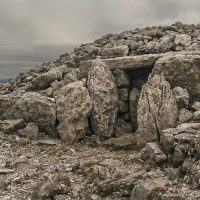The mist covered track up to Carrowkeel passage tombs pictured above adds to the mystery and mystique of the surroundings.
In the 4th millennium B. C. Carrowkeel Passage Tombs, were constructed on and around the Bricklieve hills overlooking Lough Arrow during the Neolithic age. The site was excavated in 1911 and later the findings re-examined, “A century of archaeology-historical excavation and modern research at the Carrowkeel Passage Tombs, County Sligo” was the outcome. This re-examination produced some new fascinating results that are enlightening to say the least.
It suggests Carrowkeel as a wider complex of 6km. radius incorporating Kesh Corran to the west and the Moytirra Court Tomb, (The Giant’s Cave) to the east.
This, along with, Carrowmore, (30 km north of the Carrowkeel passage tombs), are two of what is called the Big Four Megalithic monuments in Ireland along with Loughcrew and Bru na Boinne in Co. Meath. What is intriguing is they stretch almost in a line dividing the country, four large ceremonial sites to pay tribute to those who passed on to the otherworld.
They also could have been and probably were sites for rituals and festivals celebrating Imbolc (1st May celebrating Spring, growth), Bealtine 1st May (Summer celebration), Lughnasadh 1st August, harvest time and Samhain 31st October, for the Veneration of the dead.
It is thought that at festival times the high king of Ireland lit the first fire as a sign to begin festivities across the country, and when the light was seen the next fire was lit and so on across the country particularly from the sites of “the big four”.
However, in their midst, almost, is what was thought to be an open gateway to the otherworld (at Tulsk Co. Roscommon which is still, for a lot of people, a place to be kept at arms length. For now let us focus on why Rathcroghan does not change the term to “the big five”. This is where Queen Maeve is said to have ruled Connacht from around 1st century (bronze age) and constructed her ruling fortress. Close by is a tunnel called Oweynagat, the cave of the cats, or The gateway of Hell (underworld).
Is it possible The big Four were to revere and honour the dead with rituals and festivals and the Gateway to Hell was where the dead could return to the land of the living during the festival of Samhain?.
There are at least 240 identified archaeological sites including 28 burial sites from the bronze age so this could be why they are excluded as the four are of the neolithic era, a possible 3500 years before.
There were neolithic tombs here before later settlers possibly used the same sites for their burials.
Carrowkeel Passage Tombs consist of fourteen tombs at the core, some are accessible albeit on your hands and knees but that only adds to the anticipation, and twelve more, within the above mentioned 6Km radius, at Keshcorran and Seelewey, while the giant passage tomb Heapstown Cairn lies just to the north west of Carrowkeel passage tombs.
Mythology surrounding Carrowkeel passage tombs
Mythology has it, that an enormous war was fought in this vacinity, called the Second battle of Moytura, between the Tuatha De Danann and the Fomorians. There are many versions of the battle but the bottom line is that the Fomorians were defeated.
Danu the Goddess of the Tuatha De Danann ( Tribe of Danu), was possibly the Goddess of wisdom and fertility so she cared for her followers and the land. The Fomorians, on the other hand were demonic and cruel and revelled in chaos so we will rejoice in the victory.
As history is written by the victors it must surely be similar for mythological stories and at some stage they both must intertwine.
What is certain is that a visit to Carrowkeel Passage Tombs is an experience to be savoured.
For more information visit the Carrowkeel Megalithic Cemetery website.


